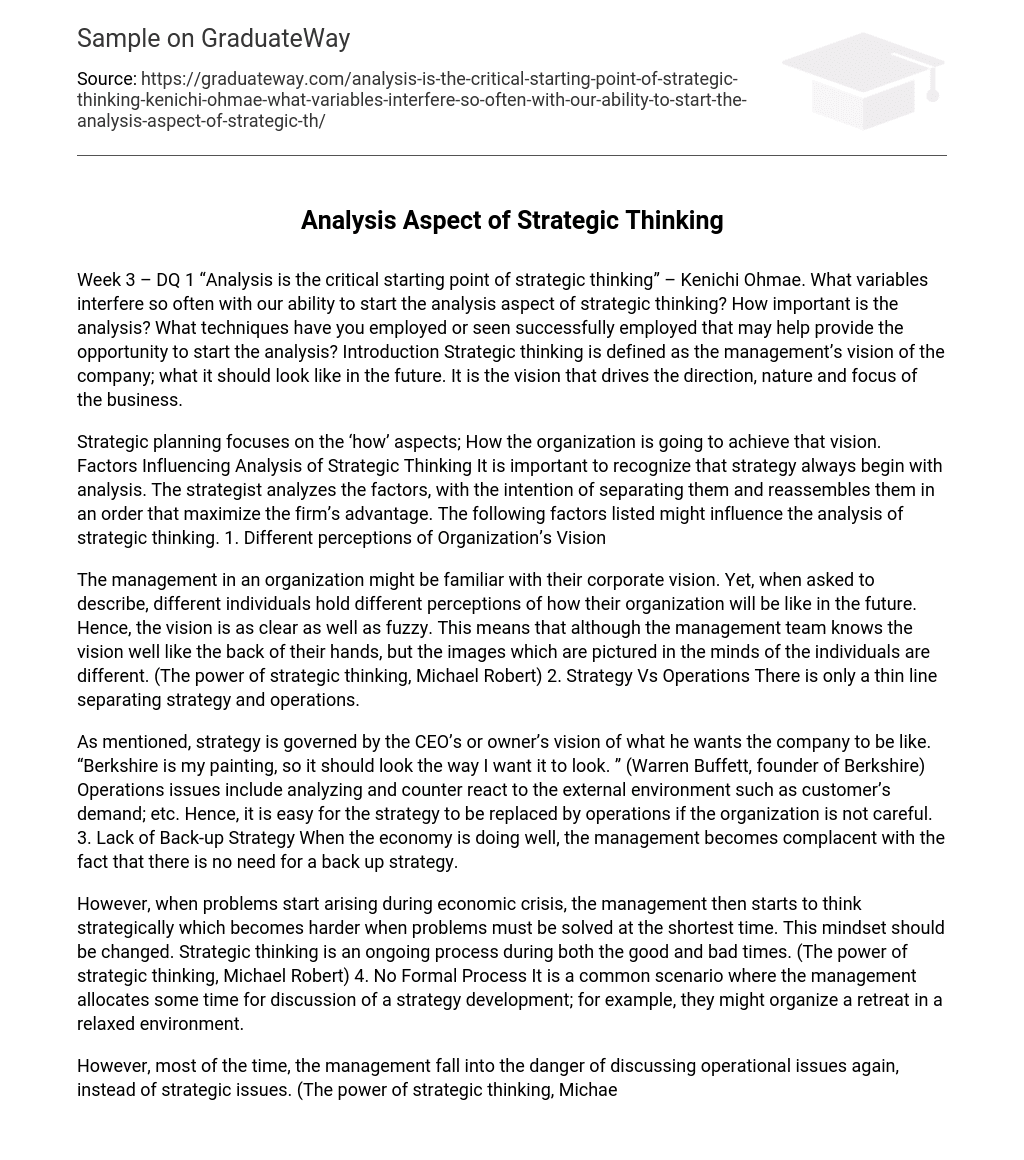“Analysis is the critical starting point of strategic thinking” – Kenichi Ohmae. What variables interfere so often with our ability to start the analysis aspect of strategic thinking? How important is the analysis? What techniques have you employed or seen successfully employed that may help provide the opportunity to start the analysis?
Strategic thinking is defined as the management’s vision of the company; what it should look like in the future. It is the vision that drives the direction, nature and focus of the business. Strategic planning focuses on the ‘how’ aspects; How the organization is going to achieve that vision.
It is important to recognize that strategy always begin with analysis. The strategist analyzes the factors, with the intention of separating them and reassembles them in an order that maximize the firm’s advantage. The following factors listed might influence the analysis of strategic thinking.
Different perceptions of Organization’s Vision. The management in an organization might be familiar with their corporate vision. Yet, when asked to describe, different individuals hold different perceptions of how their organization will be like in the future. Hence, the vision is as clear as well as fuzzy. This means that although the management team knows the vision well like the back of their hands, but the images which are pictured in the minds of the individuals are different. (The power of strategic thinking, Michael Robert)
Strategy Vs Operations. There is only a thin line separating strategy and operations. As mentioned, strategy is governed by the CEO’s or owner’s vision of what he wants the company to be like. “Berkshire is my painting, so it should look the way I want it to look. ” (Warren Buffett, founder of Berkshire) Operations issues include analyzing and counter react to the external environment such as customer’s demand; etc. Hence, it is easy for the strategy to be replaced by operations if the organization is not careful.
Lack of Back-up Strategy. When the economy is doing well, the management becomes complacent with the fact that there is no need for a back up strategy. However, when problems start arising during economic crisis, the management then starts to think strategically which becomes harder when problems must be solved at the shortest time. This mindset should be changed. Strategic thinking is an ongoing process during both the good and bad times. (The power of strategic thinking, Michael Robert)
No Formal Process. It is a common scenario where the management allocates some time for discussion of a strategy development; for example, they might organize a retreat in a relaxed environment. However, most of the time, the management fall into the danger of discussing operational issues again, instead of strategic issues. (The power of strategic thinking, Michael Robert)
Importance of Analysis in Strategic. Thinking “Analysis is the critical starting point of strategic thinking. Faced with problems, tends, events or situations that appear to constitute a harmonious whole or come packaged as a whole, the strategist dissect them into their constituent parts. Then, having discovered the significance of these constituents, he reassembles them in a way calculated to his advantage. (The Mind of a Strategist, Kenichi Ohmae)
Kenichi stressed the importance of analysis as a crucial starting point of strategic thinking. One must always take into account the problems, trends, events and situations of the external environment, and separates them for analysis. The solution is the result of the transformation or changed configuration. (The Mind of a Strategist, Kenichi Ohmae) It is easier by visualizing the external environment as a piece of paper, on which the various factors affecting the external environment are written down. The paper is then broken down into their individual factors for analysis.
Based on these individual constituents, the management is able to reassembles them to its advantage. Techniques to Help Start the Analysis The following are some successful techniques which help to kick-start the analysis in strategic thinking.
- Move Out of Comfort Zone. During good times, management should continuously aim to improve their strategies. As technology improved, there are new boundaries for thinking, planning, evaluating and improving.
- Differentiate between. ‘What’ and ‘How’ Management should be able to clearly distinguish between strategy and operation issues. They should focus on the corporate vision; Defining what the organization will look like in the future.
- Use an Ideal Vision. Ideal vision refers to the vision that is measurable in terms of performance. This will then ensure that every individual in the organization has the same picture with regards to the corporate vision.
- Defining the Need Need is defined as “the gap between current results and desired results-not gaps in resources, methods, procedures or means. ” (Kaufman, 1992) Hence, the management focuses on the organization’s priority, which is the ‘What’ issue.
It is important to identify the correct need to prevent wasting resources fixing the wrong needs.
Conclusion
An organization’s survival depends on factors such as increasing their market share in the industry, eliminating competitors, increase bargaining power with customers, successful collaboration; etc. However, perhaps the best way to gaining a competitive advantage over its competitors is to establish a distinct difference which can only be performed by the organization alone, and/or difficult for the competitors to follow.
In order to develop a difference with that of the competitors’, the company must think strategically. As strategic issues are often misconstrued as operational ones, it is essential to maintain focus. By analyzing the external environment and breaking them up into individual components, the management is then able to develop a transformed or improved solution.
References
- The power of strategic thinking, Michael Robert The Mind of a Strategist, Kenichi Ohmae Harvard Business Review, Michael E Porter, Nov-Dec 1996
- Warren Buffett, founder of Berkshire Kaufman, 1992





